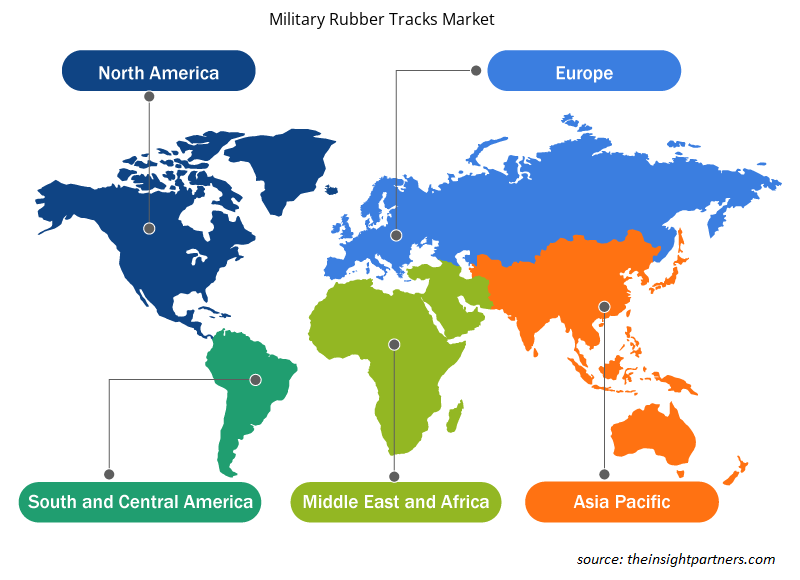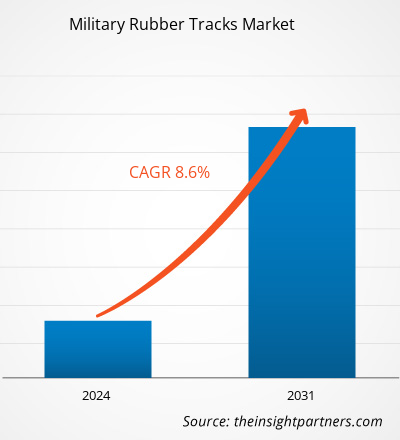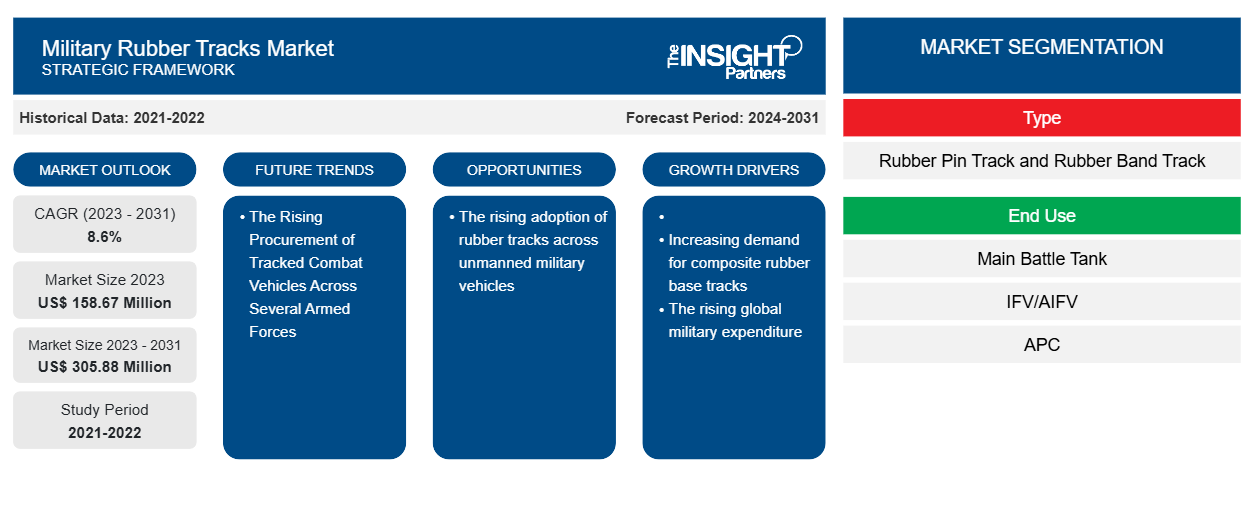Se prevé que el tamaño del mercado de orugas de caucho para uso militar alcance los 305,88 millones de dólares en 2031, frente a los 158,67 millones de dólares en 2023. Se espera que el mercado registre una tasa de crecimiento anual compuesta (CAGR) del 8,6 % durante el período 2023-2031. Es probable que la creciente adopción de orugas de caucho para satisfacer la creciente producción de vehículos militares no tripulados siga siendo una tendencia clave en el mercado.
Análisis del mercado de orugas de caucho para uso militar
El ecosistema del mercado de orugas de caucho para uso militar comprende las siguientes partes interesadas: proveedores de materias primas, fabricantes de orugas de caucho para uso militar y usuarios finales. Los proveedores de materias primas suministran materiales como caucho, polímeros y metal para fabricar orugas de caucho para uso militar. Los fabricantes de orugas de caucho para uso militar llevan a cabo procesos como el diseño y la producción para transformar la materia prima en el producto terminado. Los fabricantes de orugas de caucho para uso militar venden sus productos a diferentes usuarios finales, como las fuerzas armadas. Esto ayuda a los fabricantes a obtener mayores ingresos, catalizando así el crecimiento del mercado de orugas de caucho para uso militar.
Descripción general del mercado de orugas de caucho militares
Aunque las orugas de goma han experimentado una rápida adopción en varios tipos de vehículos militares , las orugas de acero son las preferidas principalmente por su durabilidad en terrenos duros. Las orugas de goma son menos duraderas que las de acero en superficies duras como colinas y montañas. Las orugas de acero también ofrecen más tracción debido a su peso y distribución de la carga en superficies de barro y nieve. Las orugas de goma son vulnerables a la temperatura; se vuelven frágiles con el frío y maleables con el calor. En caso de operar en condiciones climáticas adversas, las fuerzas militares enfrentan desafíos al usar orugas de goma o almohadillas de goma en comparación con las orugas de acero. Estos factores han estado afectando al mercado de orugas de goma militares.
Personalice este informe según sus necesidades
Obtendrá personalización en cualquier informe, sin cargo, incluidas partes de este informe o análisis a nivel de país, paquete de datos de Excel, así como también grandes ofertas y descuentos para empresas emergentes y universidades.
-
Obtenga las principales tendencias clave del mercado de este informe.Esta muestra GRATUITA incluirá análisis de datos, desde tendencias del mercado hasta estimaciones y pronósticos.
Impulsores y oportunidades del mercado de orugas de caucho para uso militar
Creciente adopción de orugas de caucho compuesto (CRT) en aplicaciones militares
Las ventajas de las orugas de caucho compuesto (CRT) sobre las orugas de caucho de acero tradicionales, como la necesidad de un menor mantenimiento, una menor carga con una mayor durabilidad y una mejor frecuencia de reemplazo. Las SRT requieren un mantenimiento de componentes como eslabones, ruedas dentadas y ruedas de carretera que deben reemplazarse cada 600 km, mientras que las CRT son un producto de bajo mantenimiento que tiene la capacidad de operar hasta 5000 km sin mantenimiento o reemplazo de componentes estructurales. Además, el consumo de combustible de los vehículos militares basados en CRT es mucho menor que el de los vehículos militares basados en SRT. Según el análisis de los socios de Insight, comparar los vehículos blindados de transporte de personal (APC) y los vehículos de combate de infantería (IFV) con orugas de acero con los que tienen CRT es más eficiente para ahorrar al menos un 30% en el uso de combustible.
La creciente adquisición de vehículos de combate con orugas por parte de varias fuerzas armadas
Los actores clave que operan en el mercado mundial de orugas de caucho militares incluyen a Astrak UK Limited, DST Defence Service Tracks GmbH, GMT Rubber-Metal-Technic Ltd y Mackay Consolidated Industries Pty Ltd. Estas empresas están constantemente firmando nuevos contratos para suministrar orugas de caucho a varios fabricantes de vehículos militares en todo el mundo debido al aumento en la adquisición de vehículos militares con orugas por parte de varias fuerzas militares:
- En abril de 2024, el Ejército de EE. UU. adjudicó un contrato por valor de 754 millones de dólares a BAE Systems Plc para iniciar la segunda fase de fabricación de vehículos blindados multiusos (AMPV).
- En julio de 2023, General Dynamics Land Systems ganó un contrato del Ejército de los EE. UU. por valor de 257,6 millones de dólares estadounidenses para la segunda fase de la producción inicial a baja velocidad del nuevo vehículo de combate M10 Booker (26 unidades), anteriormente conocido como Mobile Protected Firepower.
Es probable que este tipo de adquisición de vehículos militares con orugas genere nuevas oportunidades para los vendedores del mercado de orugas de caucho militares en los próximos años.
Informe de mercado de orugas de caucho militares Análisis de segmentación
Los segmentos clave que contribuyeron a la derivación del análisis del mercado de orugas de caucho militares son el tipo y el uso final.
- Según el tipo, el mercado de orugas de caucho militares se divide en orugas de pasador de caucho y orugas de banda de caucho. El segmento de orugas de pasador de caucho tuvo una mayor participación de mercado en 2023.
- Según el uso final, el mercado de orugas de caucho militares se segmenta en tanques de batalla principales, vehículos de combate de infantería y vehículos de combate de infantería, vehículos blindados de transporte de personal y otros. El segmento de vehículos blindados de transporte de personal tuvo una mayor participación de mercado en 2023.
Análisis de la cuota de mercado de orugas de caucho militares por geografía
El alcance geográfico del informe del mercado de orugas de caucho militares se divide principalmente en cinco regiones: América del Norte, Europa, Asia Pacífico, Medio Oriente y África, y América del Sur.
En 2023, América del Norte ha dominado el mercado, seguida de Europa y Asia Pacífico. Además, es probable que Asia Pacífico experimente la CAGR más alta en los próximos años. Con el creciente enfoque en mejorar la maniobrabilidad de los vehículos blindados y el aumento del presupuesto gubernamental para la adquisición de vehículos blindados avanzados, y el aumento de las operaciones de mantenimiento, reparación y revisión (MRO) de los vehículos blindados militares, se proyecta que el mercado de orugas de banda de goma experimente una tracción significativa durante el período de pronóstico. Estados Unidos tiene el presupuesto de defensa más alto del mundo. El gasto militar del país en 2022 fue de US$ 876,94 mil millones, que creció a US$ 916 mil millones en 2023. Northern Plains Track y Hutchinson Industries Inc. son las empresas clave que proporcionan orugas de caucho militares en los EE. UU. Estos factores han impulsado el crecimiento del mercado de orugas de caucho militares de América del Norte.
Perspectivas regionales del mercado de orugas de caucho militares
Los analistas de Insight Partners explicaron en detalle las tendencias y los factores regionales que influyen en el mercado de orugas de caucho militares durante el período de pronóstico. Esta sección también analiza los segmentos y la geografía del mercado de orugas de caucho militares en América del Norte, Europa, Asia Pacífico, Oriente Medio y África, y América del Sur y Central.

- Obtenga datos regionales específicos para el mercado de orugas de caucho militares
Alcance del informe de mercado de orugas de caucho militares
| Atributo del informe | Detalles |
|---|---|
| Tamaño del mercado en 2023 | US$ 158,67 millones |
| Tamaño del mercado en 2031 | US$ 305,88 millones |
| CAGR global (2023 - 2031) | 8,6% |
| Datos históricos | 2021-2022 |
| Período de pronóstico | 2024-2031 |
| Segmentos cubiertos |
Por tipo
|
| Regiones y países cubiertos |
América del norte
|
| Líderes del mercado y perfiles de empresas clave |
|
Densidad de actores del mercado de orugas de caucho militares: comprensión de su impacto en la dinámica empresarial
El mercado de orugas de caucho para uso militar está creciendo rápidamente, impulsado por la creciente demanda de los usuarios finales debido a factores como la evolución de las preferencias de los consumidores, los avances tecnológicos y una mayor conciencia de los beneficios del producto. A medida que aumenta la demanda, las empresas amplían sus ofertas, innovan para satisfacer las necesidades de los consumidores y aprovechan las tendencias emergentes, lo que impulsa aún más el crecimiento del mercado.
La densidad de actores del mercado se refiere a la distribución de las empresas o firmas que operan dentro de un mercado o industria en particular. Indica cuántos competidores (actores del mercado) están presentes en un espacio de mercado determinado en relación con su tamaño o valor total de mercado.
Las principales empresas que operan en el mercado de orugas de caucho militares son:
- Astray Reino Unido Limitada
- DST Defence Service Tracks GmbH
- GMT Rubber-Metal-Technic Ltd
- Industrias consolidadas de Mackay Pty Ltd
- Compañía de caucho Martin's Limited
Descargo de responsabilidad : Las empresas enumeradas anteriormente no están clasificadas en ningún orden particular.

- Obtenga una descripción general de los principales actores clave del mercado de orugas de caucho militares
Noticias y desarrollos recientes del mercado de orugas de caucho para uso militar
El mercado de orugas de caucho para uso militar se evalúa mediante la recopilación de datos cualitativos y cuantitativos a partir de una investigación primaria y secundaria, que incluye importantes publicaciones corporativas, datos de asociaciones y bases de datos. A continuación, se enumeran algunos de los avances en el mercado de orugas de caucho para uso militar:
Canadian Commercial Corporation (CCC) se complace en anunciar que el Departamento de Defensa de los Estados Unidos (US DoD) le ha otorgado un contrato para suministrar al ejército estadounidense caucho kevlar para el lado molido de los tanques T-107 fabricado por Soucy Techno. (Fuente: Excella, comunicado de prensa, abril de 2024)
- Rheinmetall, el mayor proveedor de vehículos militares de las Fuerzas de Defensa de Australia, ha completado con éxito las pruebas de demostración del sistema de orugas de caucho compuesto (CRT) Soucy en el vehículo de combate de infantería Lynx KF41. (Fuente: Rheinmetall AG, comunicado de prensa, noviembre de 2021)
Informe sobre el mercado de orugas de caucho para uso militar: cobertura y resultados
El informe “Tamaño y pronóstico del mercado de orugas de caucho militares (2021-2031)” proporciona un análisis detallado del mercado que cubre las siguientes áreas:
- Tamaño del mercado de orugas de caucho militares y pronóstico a nivel mundial, regional y nacional para todos los segmentos clave del mercado cubiertos bajo el alcance
- Tendencias del mercado de orugas de caucho militares, así como dinámica del mercado, como impulsores, restricciones y oportunidades clave
- Análisis detallado de las cinco fuerzas de Porter
- Análisis del mercado de orugas de caucho militares que abarca las tendencias clave del mercado, el marco global y regional, los principales actores, las regulaciones y los desarrollos recientes del mercado
- Análisis del panorama de la industria y de la competencia que abarca la concentración del mercado, el análisis de mapas de calor, los actores destacados y los desarrollos recientes del mercado de orugas de caucho militares
- Perfiles detallados de empresas
- Análisis histórico (2 años), año base, pronóstico (7 años) con CAGR
- Análisis PEST y FODA
- Tamaño del mercado, valor/volumen: global, regional y nacional
- Industria y panorama competitivo
- Conjunto de datos de Excel
Informes recientes
Informes relacionados
Testimonios
Razón para comprar
- Toma de decisiones informada
- Comprensión de la dinámica del mercado
- Análisis competitivo
- Información sobre clientes
- Pronósticos del mercado
- Mitigación de riesgos
- Planificación estratégica
- Justificación de la inversión
- Identificación de mercados emergentes
- Mejora de las estrategias de marketing
- Impulso de la eficiencia operativa
- Alineación con las tendencias regulatorias























 Obtenga una muestra gratuita para - Mercado de orugas de caucho militares
Obtenga una muestra gratuita para - Mercado de orugas de caucho militares